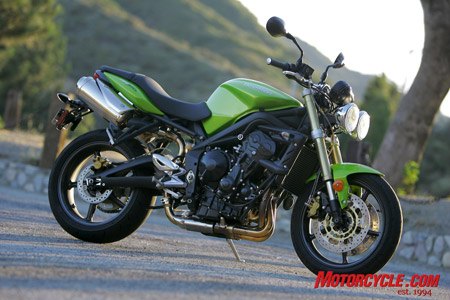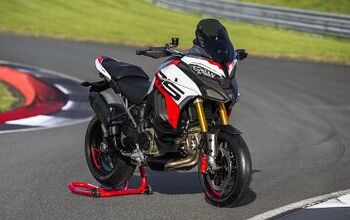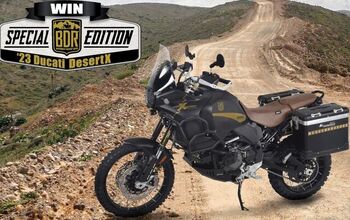2008 Triumph Street Triple 675 Review - Motorcycle.com
Get the Flash Player to see this player.
L’ enfant terrible can be found even in the mechanized world. The normally conservative family of Triumph spawned a bad seed last year and his name is Street Triple 675. The Street is the snarky, unruly-on-command evil twin of its high-achiever mate, the Daytona 675. Some may also rightly call the Street the little brother of the Speed Triple, a bike birthed by Triumph some 14 years ago.
The motorcycle company from Hinckley, England, sees the Street as being born, in concept at least, at the same time as the exceptionally successful Daytona 675. The Daytona was “designed from the start with a naked version in mind,” according to Triumph press materials. As evidence to that claim, the company points to the location of bodywork bracket mounts placed inside the frame, leaving a clean look for the Street once it started production. And in a nod to how the Brit company perceives this middleweight naked, it states specifically that the Street wasn’t to be a “Daytona with the bodywork off,” but that it should hearken to the style of the hooligan-magnet Speed Triple. The company even goes so far as to refer to the look as “recognisably Triumph.”
Sibling rivalry
Being of the ilk of the Daytona, the Street retains a great deal of the supersport’s DNA. Both share the same twin-spar aluminum frame; the braced, aluminum swingarm is also the same, yet on the Street Triple the pivot point is set 2mm lower and apparently adjustable within that range. Since the naked machine has precious few attachment points, the twin-spotty headlamp borrowed directly from the Speed Triple and instrument cluster that details the same info (save for the lower redline) as on the Daytona, are both rubber mounted. The subframe on the Street is also slightly different.
The 5-spoke wheels are off the Daytona, as is the pair of floating 308mm brake rotors.
The Daytona 675 has a supersport class-standard set of radial-mount calipers actuated by a radial-pump brake master cylinder. The Street Triple, however, scales down a bit as it uses a pair of two-piston sliding-pin calipers. Sliding-pin? Was the Queen consulted about this? Rather than cast aspersions, I set my notions aside and gave them a chance. Squeezed often enough under “assertive” riding, the brakes will suffer some fade despite stainless-steel lines and what is supposed to be the same pad material used on the Daytona. Ultimately, they’re sufficient, but the more precise feel and extra stopping power of commonly used four-pot binders (like on the Daytona) would be a nice addition.
'…the Street Triple is the one who broke into the classroom, stole the test answers out of the teacher’s desk, did a smoky burnout and wheelied away'
Where the race-like bike is suspended by fully adjustable kit front and rear, the Street’s Kayaba fork, although 41mm and inverted, is entirely un-adjustable, and the Kayaba shock is good for pre-load adjustments only. However, the twin locking-rings could be adjusted from across the room as the top of the shock is incredibly accessible.
Riding the nude Triple (note I didn’t say riding the Triple nude) is enjoyable over mostly smooth road surfaces. The bike remains stable while cornering, but crummy pavement starts to reveal poor damping up front. High-speed (i.e. sharp-angled) bumps result in a bit of a jarring ride; consistently rough roads also become less-than-fun thanks to the simplistic shock, but the grippy Dunlop Sportmax Qualifiers fitted as OE help keep things in check.
Original GangstasThe origin of the look and attitude of the Speed Triple wasn’t the synaptic genius of some designer; rather it came from the true “streetfighters” found zipping around the narrow streets and serpentine country roads of Ol’ Blighty, some 17 or so years ago. These rat bikes are the source of inspiration for the three-cylinder Speed Triple first introduced in 1994 with an 885cc mill, now a 1050cc.
English bikers, ever imaginative, would simply strip damaged bodywork, and any other bits gone bad in a smash up, from their early-model GSX-Rs or similar sports bikes, leaving it mostly unfaired primarily because they couldn’t afford the stock replacements. Snapped clip-ons were replaced with motocross handlebars, and a headlight or two sourced elsewhere replaced the OEM piece left in the ditch. The machines took on post-apocalyptic survivor appearances as it was plainly obvious they didn’t start out looking that way. Somehow, the look survived and was befitting of the rough and tumble grittiness of an EastEnder.
There is some controversy as to whether the English pioneered the look or if it was born in Germany. Either way, our Limey friends are most readily credited for streetfighters.
The Speed wasn’t the genesis of the streetfighter look, but kudos to Triumph for capitalizing so brilliantly on its fellow countrymen’s resourcefulness. And they’ve got the numbers to support the smart move. Reporting back from his time at Triumph’s 2008 Urban Sports launch, Kevin Duke told us that after a Marabese-penned redesign in 2005 the Speed was re-established “as Triumph’s best seller, retailing about 6600 units that accounted for more than 20% of the British factory’s total sales [in 2005]. It proved to be especially popular in style-conscious Italy where more than 1700 were sold.”
Jim Callahan, Triumph’s North American Marketing Manager says it plainly. “[T]he Speed Triple is a cornerstone of our commercial success and represents the signature style of our brand.”
Despite the Street’s claimed 4-pound dry weight gain (367 vs. 363 lbs) and slower steering geometry (24.3-degree rake; 3.75-inches trail; 54.9-inch wheelbase) compared to the Daytona’s sharper measurements (23.5 degrees; 3.41 inches; 54.8 inches, respectively), the Street makes up for increased initial effort with good leverage offered by the motocross-type handlebars.
Those bars also make for an oh-so-comfortable upright riding position when paired with footpegs 25mm (0.9-inch) lower and 14mm (0.5-inch) further forward than on the Daytona. It’s conceivable, though, if a rider were, say, greater than 5-foot 10-inches tall, the ride could get cramped. The seat is wide enough without hindering ease of movement, and is 0.9-inch lower than the Daytona’s saddle (31.6 vs. 32.5), yet the foam near the very front compresses easily, making for a fidgety rider before long.
A problem child with a heart of gold
Editor Duke and guest tester Mark Gardiner labeled the Daytona a “cheater” in our recent 2008 Supersport Shootout because of its outstanding engine. If that’s the case, then the Street Triple is the one who broke into the classroom, stole the test answers out of the teacher’s desk, did a smoky burnout and wheelied away.
Just as you were about to lampoon me for skipping over the engine, fear not, I’ve saved the best for last. Yes, this 675cc fuel-injected, liquid-cooled, DOHC inline-Triple has the same bore and stroke of 74 x 52.3mm and 12.6:1 compression ratio as the Daytona. But in the case of the Street Triple the powerplant is made even more accessible and user-friendly for street duty by way of reduced valve lift and overlap on both intake and exhaust cams (9.25 to 8mm; 8.5 to 7.25mm). Peak torque of 43.5 ft-lbs at 9800 rpm and a max of 91.1 hp at 12,100 rpm were measured on Mickey Cohen Motorsports dyno. In our Supersport Shootout this year, the Daytona 675 twisted out nearly 48 ft-lbs at 10,200 rpm with 106.5 hp at 12,500 rpm. Trust me, with the Street’s super-flat torque curve appearing so early in the rev range and maintaining peak or near peak for so long, on public roads you probably won’t be able to perceive the Street’s slight power deficit to the Daytona.
Fueling is spot-on, as is throttle response. Regardless of constant flogging of the twistgrip, the Street still managed 38 mpg on average from the 4.6-gallon tank. And just like the Daytona, clutch action is light and shifting from the six-speed is the tiniest bit notchy.
I really, really, like the look of this motorcycle. And I like even more the ever-present torque that had me wheeling from every, and I mean every, stop, or dug me out of a canyon corner when running one gear too high. Key for maximum fun was keeping the engine boiling around 8k rpm and above. Mix those characteristics together with the incomparable throaty note that only an inline three-cylinder can offer as it snorts and growls through the intake and twin high-mount stubby mufflers, and the challenge to avoid being a guest at the county motel begins.
Said exhaust silencer placement limits bungee attachment points to one, maybe two, if you’re creative. On a good note I gleefully report the absence of any comfort-related heat issues from the exhaust system. No small thing in this very hot SoCal summer we’re having.
“Pfffffff...” was the sound of the rapidly deflating balloon I heard in my head when I spied the MSRP of the ’08 Street Triple. The killer engine in this bike would have made it easier to swallow the sticker of $7999 when this bike first hit showrooms. Alas, world economies have suffered recently and so have the costs of raw materials according to Triumph’s Callahan. As of April of this year the poor lil’ Street got bumped to $8299, only $700 less than the $8999 of the Daytona. In the words of my English ex-pat friends, “Fookin’ ‘ell, mate!”
This, then, presents the buyer who has some mechanical aptitude with something of a dilemma. Buy the Street with the lesser-spec brakes and suspension, or go gorilla on a Daytona and have two bikes for a little more than the price of one? I know what I’d do before the price of something else went up. If you’re ascared of tools or sort of new to motorcycling, you could do worse things than buy the Street at current full retail.
However you feel about price, or draw the family tree, one thing is true of the Street Triple 675. Like those miscreants you grew up with or knew from your neighborhood, this little hooligan can draw the troublemaker out in you if given half a chance.
| The Perfect Bike For... | ||
| Someone who’s looking to unleash their inner hooligan with a light-weight, user-friendly, torque machine and doesn’t want to wreck a bike to get it. | ||
| Highs: | Sighs: | |
| Turn-key streetfighter look Flexible and accessible 675cc Triple Unmatched intake and exhaust note | Thinly padded seat Budget brakes and suspension Current economic climate hurts value | |
More by Pete Brissette



































Comments
Join the conversation